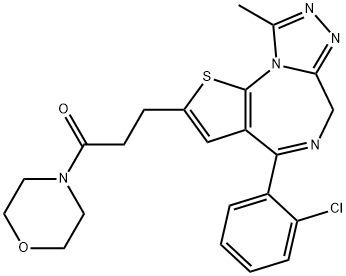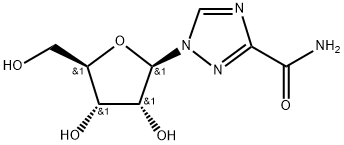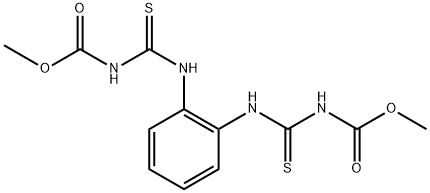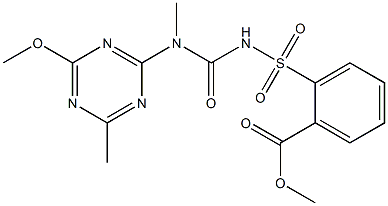Apafant
Synonym(s):3-[4-(2-Chlorophenyl)-9-methyl-6H-thieno[3,2-f][1,2,4]triazolo[4,3-a][1,4]diazepin-2-yl]-1-(4-morpholinyl)-1-propanone;Apafant;WEB 2086BS
- CAS NO.:105219-56-5
- Empirical Formula: C22H22ClN5O2S
- Molecular Weight: 455.96
- MDL number: MFCD00865271
- SAFETY DATA SHEET (SDS)
- Update Date: 2024-11-19 15:53:33

What is Apafant?
Description
WEB-2086 (105219-56-5) is a potent and selective antagonist of the platelet activating factor (PAF) receptor (Ki = 16.3 nM).1?Displays an activity profile which includes antiinflammatory, antiangiogenesis and anticancer activity.2?Along with leukotriene antagonists, WEB-2086 cooperatively provides a robust antiinflammatory effect regulating PMNL migration and edema formation.3?Displays analgesic effects in animal models of neuropathic pain.4?Active in vivo.
Chemical properties
White Solid
The Uses of Apafant
Platelet activating factor (PAF) antagonist.
The Uses of Apafant
Tool to evaluate the role of PAF in experimental models of human disease.
What are the applications of Application
WEB-2086 is a PAF-R antagonist shown to have anticancer effects
Definition
ChEBI: LSM-2613 is an organonitrogen heterocyclic compound and an organosulfur heterocyclic compound.
Biological Activity
Potent, selective platelet-activating factor (PAF) receptor antagonist (K i = 16.3 nM). Displays anti-inflammatory, antiangiogenic and anticancer activity. Inhibits growth and proliferation of MCF-7 breast cancer cells.
Biochem/physiol Actions
WEB2086 is a very potent, selective platelet-activating factor (PAF) antagonist (IC50 = 16 nM). WEB2086 inhibits the proliferation of tumor cells and slows tumor growth in xenograft tumor models, and has been shown to inhibit angiogenesis.
storage
Desiccate at +4°C
References
1) Dent et al. (1989), Characterization of PAF receptors on human neutrophils using the specific antagonist WEB 2086. Correlation between receptor binding and function; FEBS Lett., 244 365 2) Cellai et al. (2006), Growth inhibition and differentiation of human breast cancer cells by PAFR antagonist WEB-2086; Br. J. Cancer, 94 1637 3) Bitencourt et al. (2013), Cooperative role of endogenous leucotrienes and platelet-activating factor in ischaemia-reperfusion-mediated tissue injury; J. Cell. Mol. Med., 17 1554 4) Motoyama et al. (2013), Pain-releasing action of platelet-activating factor (PAF) antagonists in neuropathic pain animal models and the mechanisms of action; Eur. J. Pain, 17 1156
Properties of Apafant
| Melting point: | 186-188°C |
| Boiling point: | 720.2±70.0 °C(Predicted) |
| Density | 1.48 |
| storage temp. | 2-8°C |
| solubility | DMSO: soluble10mg/mL (clear solution) |
| pka | 2.36±0.40(Predicted) |
| form | powder |
| color | white to beige |
| Stability: | Stable for 2 years from date of purchase as supplied. Solutions in DMSO or ethanol may be stored at -20° for up to 3 months. |
Safety information for Apafant
Computed Descriptors for Apafant
New Products
Tert-butyl bis(2-chloroethyl)carbamate (S)-3-Aminobutanenitrile hydrochloride N-Boc-D-alaninol N-BOC-D/L-ALANINOL N-octanoyl benzotriazole 4-Hydrazinobenzoic acid 3,4-Dibenzyloxybenzaldehyde Electrolytic Iron Powder 1,1’-CARBONYLDIIMIDAZOLE R-2-BENZYLOXY PROPIONIC ACID 4-HYDROXY BENZYL ALCOHOL 1,1’-CARBONYLDI (1,2-4 TRIAZOLE) S-2-CHLORO PROPIONIC ACID (2-Hydroxyphenyl)acetonitrile 4-Bromopyrazole 5-BROMO-2CYANO PYRIDINE 5,6-Dimethoxyindanone 5-broMo-2-chloro-N-cyclopentylpyriMidin-4-aMine 3-(Hydroxymethyl)benzoate N-Boc-2-chloroethylamine 1-Bromo-2-methoxy-3-nitrobenzene N-Methyl-3-cyclopenten-1-amine 2-Bromo-3-hydroxybenzaldehyde 1H-indazole-5-carboxamideRelated products of tetrahydrofuran








You may like
-
 WEB2086 CAS 105219-56-5View Details
WEB2086 CAS 105219-56-5View Details
105219-56-5 -
 7441-43-2 98%View Details
7441-43-2 98%View Details
7441-43-2 -
 1260741-78-3 6-Bromo-3-iodo-1-methyl-1H-indazole 98%View Details
1260741-78-3 6-Bromo-3-iodo-1-methyl-1H-indazole 98%View Details
1260741-78-3 -
 4-bromo-3,5-dimethylbenzenesulfonyl chloride 1581266-79-6 98%View Details
4-bromo-3,5-dimethylbenzenesulfonyl chloride 1581266-79-6 98%View Details
1581266-79-6 -
 2490430-37-8 98%View Details
2490430-37-8 98%View Details
2490430-37-8 -
 N-(5-Amino-2-methylphenyl)acetamide 5434-30-0 98%View Details
N-(5-Amino-2-methylphenyl)acetamide 5434-30-0 98%View Details
5434-30-0 -
 124371-59-1 98%View Details
124371-59-1 98%View Details
124371-59-1 -
 53857-52-2 98%View Details
53857-52-2 98%View Details
53857-52-2